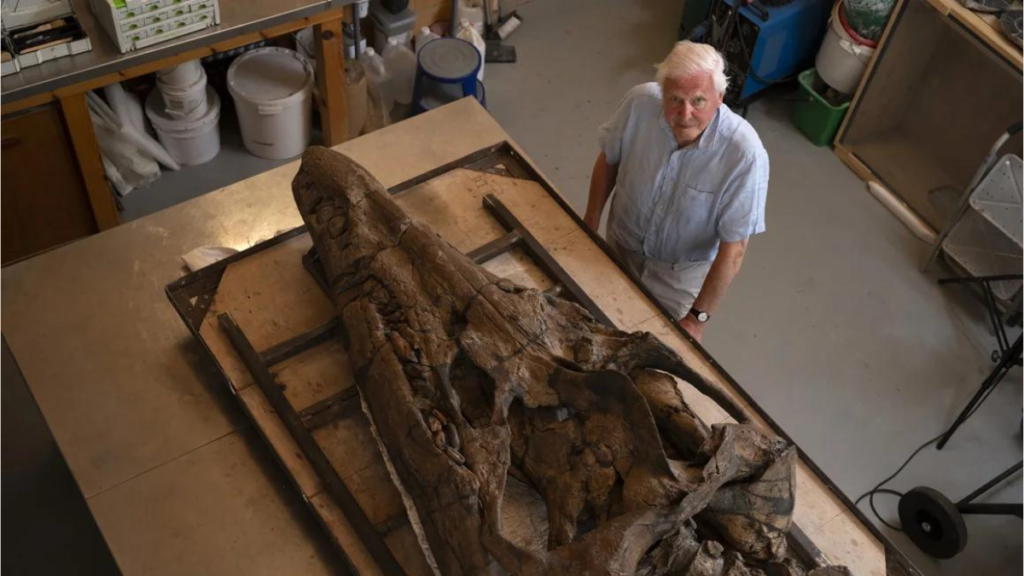A colossal pliosaur skull, dating back 150 million years, has been discovered along the Jurassic Coast in Dorset, England. The fossil, nearly 2 meters in length, is almost 3 million years younger than any other known pliosaur specimen and has researchers exploring the possibility of it being a previously undiscovered species. The discovery is set to be revealed in the BBC documentary “Attenborough and the Jurassic Sea Monster,” featuring Sir David Attenborough. The fossil’s discovery and restoration efforts began in spring 2022 when Philip Jacobs discovered the pliosaur’s snout on the beach. The fossil offers insights into the life of these predators, with its razor-sharp teeth and sensory pits on its skull. The fossil’s massive size suggests it could effectively prey on anything unfortunate enough to share its space. The discovery opens a window into the ancient marine world, providing scientists with a rare opportunity to study and understand the behaviors of these remarkable creatures.
Unprecedented Age and Potential New Species:
Pliosaurs, formidable carnivorous marine reptiles, were contemporaries of land-dwelling dinosaurs. The recently unearthed fossil, almost 3 million years younger than any other known pliosaur specimen, has researchers intrigued about the possibility of it being a previously undiscovered species. The fossil’s age and exceptional preservation make it a treasure trove for scientific inquiry.
Attenborough’s Exploration:
The discovery is set to be unveiled in the upcoming BBC documentary “Attenborough and the Jurassic Sea Monster,” featuring the legendary naturalist Sir David Attenborough. The documentary, scheduled to air on PBS on February 14, 2024, chronicles the intricate excavation and scientific investigation of this colossal pliosaur skull.
Enormous Size and Delicate Extraction:
The pliosaur’s skull, nearly 2 meters (6.6 feet) in length, was found embedded in a cliff along Dorset’s Jurassic Coast. The fossilized specimen, weighing over half a metric ton, reflects the colossal proportions of these ancient marine predators, which could grow up to 15 meters (50 feet) in length, according to Encyclopaedia Britannica.
Local paleontologist Steve Etches, a key figure in the excavation, shared the challenges of extracting the fossil from the cliff, situated about 11 meters (36 feet) above ground and 15 meters (49 feet) down. The operation was conducted with urgency, racing against the threat of summer storms and potential cliff erosion that could have obliterated this rare and significant find.
Discovery and Restoration Efforts:
The journey of this extraordinary fossil began in spring 2022 when Philip Jacobs discovered the pliosaur’s snout on the beach. Excitement surged as paleontologists realized the completeness of the fossil, with jaws that closed together. Steve Etches and his team employed drones to map the precise location in the cliff before undertaking a daring three-week operation, chiseling into the cliff while suspended in midair.
The restoration of the skull proved to be a meticulous task undertaken by Etches. Despite initial challenges with cracked mud and bone, Etches described the process as akin to assembling a jigsaw puzzle. The fossil’s remarkable condition, according to Etches, is a “freak of nature” attributed to the right environmental conditions, including rapid sedimentation after the creature’s demise.
Insights into Pliosaur Behavior:
The nearly intact pliosaur fossil offers a glimpse into the life of these formidable predators. The apex predator, armed with huge razor-sharp teeth, utilized a range of senses, including visible sensory pits on its skull that may have facilitated the detection of changes in water pressure. The fossil’s characteristics highlight its prowess as a top predator, showcasing a bite force twice as powerful as today’s saltwater crocodile, according to Professor Emily Rayfield from the University of Bristol.
Andre Rowe, a postdoctoral research associate of paleobiology at the University of Bristol, emphasized the pliosaur’s massive size, suggesting it could effectively prey on anything unfortunate enough to share its space.
Conclusion:
The discovery of this colossal pliosaur skull on England’s Jurassic Coast opens a window into the ancient marine world, providing scientists with a rare opportunity to study and understand the behaviors of these remarkable creatures. As the world awaits the broadcast of “Attenborough and the Jurassic Sea Monster,” the fossil stands as a testament to the ongoing wonders hidden within the Earth’s geological layers, awaiting discovery by intrepid scientists and researchers.







